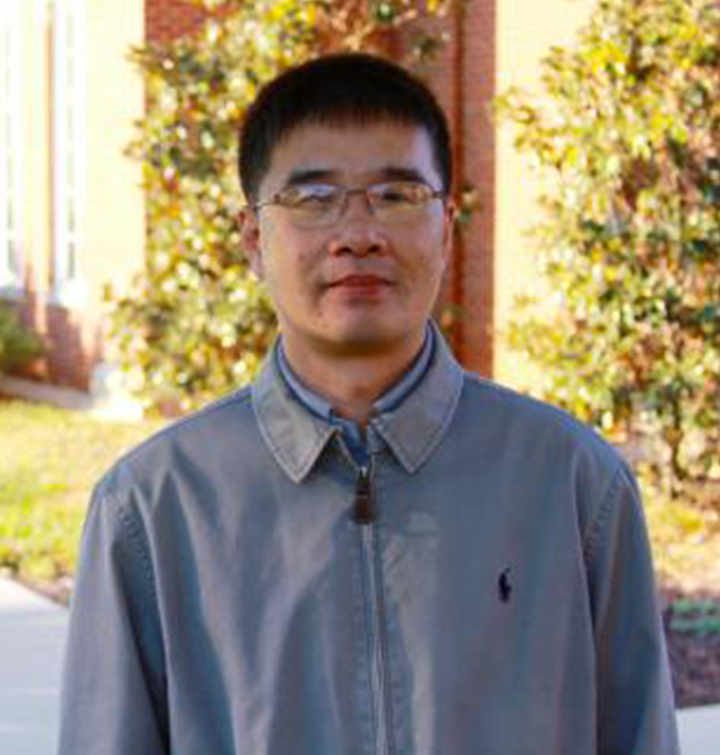Education
Ph.D. Environmental Engineering, University of Michigan, Ann Arbor
B.S. Environmental Chemistry, Nanjing University, China
Honors, Awards, and Achievements
D.W. Brooks Award for Excellence in Research, 2018
UGA Interdisciplinary Innovative Research Award, 2016
International Expert Lectureship, Shanghai Academy of Agricultural Sciences, 2014
Baiyulan Award for Nanotechnology Research, 2010
Graduate Student Research Mentor Award, University of Michigan, 2005
Research Interests
Dr. Huang’s research interest focuses on catalysis involved in the environmental transformation of organic pollutants and development of catalysis-based technology for pollution control and environmental remediation and management.
His laboratory has been actively involved in four cutting-edge research topics:
- enzyme-based technology for water/wastewater treatment and soil remediation
- electrochemical and reactive electrochemical membrane processes in wastewater treatment
- catalysis in biofuel production and agro-ecosystem management
- environmental application and implication of nanomaterials
Selected Publications
Wang Y., Shi H., Li C., & Huang Q., 2020, Electrochemical degradation of perfluoroalkyl acids by titanium suboxide anodes. Environmental Science: Water Research & Technology, 6(1), 144-152.
Wang L., Lu J., Li L., Wang Y., & Huang, Q., 2020, Effects of chloride on electrochemical degradation of perfluorooctanesulfonate by Magnéli phase Ti4O7 and boron doped diamond anodes. Water Research, 170, 115254.
Zhong C., Zhao H., Cao H., & Huang Q., 2019, Polymerization of micropollutants in natural aquatic environments: A review. Science of the Total Environment, 133751.
Yang P., Ji Y., Lu J., & Huang Q., 2019, Formation of nitrophenolic byproducts during heat-activated peroxydisulfate oxidation in the presence of natural organic matter and nitrite. Environmental Science & Technology, 53(8), 4255-4264.
Sidhu S. S., Huang Q., Carrow R. N., & Raymer, P. L., 2019, Short-term and Residual Effects of Laccase Application on Creeping Bentgrass Thatch Layer. HortScience, 54(9), 1610-1620.
Shi H., Wang Y., Li C., Pierce R., Gao S., & Huang Q., 2019, Degradation of Perfluorooctanesulfonate by Reactive Electrochemical Membrane Composed of Magneli Phase Titanium Suboxide. Environmental Science & Technology, 53(24), 14528-14537.
Qi H., Huang Q., & Hung Y.-C., 2019, Efficacy of activated persulfate in pathogen inactivation: A further exploration. Food Research International, 120, 425-431.
Liu J., Hu C., & Huang Q., 2019, Adsorption of Cu2+, Pb2+, and Cd2+ onto oiltea shell from water. Bioresource Technology, 271, 487-491.
Liu J., Chen F., Li C., Lu L., Hu C., Wei Y., Raymer P., Huang Q., 2019, Characterization and utilization of industrial microbial waste as novel adsorbent to remove single and mixed dyes from water. Journal of Cleaner Production, 208, 552-562.
Luo Q., Yan X., Lu J., Huang Q., 2018, Perfluorooctanesulfonate degrades in a laccase-mediator system, Environmental Science and Technology, 52, 10617-10626.
Liang S., Lin H, Habteselassie M., Huang Q. 2018, Electrochemical inactivation of bacteria with a titanium sub-oxide reactive membrane, Water Research, 145, 172-180.
Lin H., Niu J., Liang S., Wang C., Wang Y., Jin F., Luo Q., Huang Q., 2018, Development of macroporous Magnéli phase Ti4O7 ceramic materials: As an efficient anode for mineralization of poly- and perfluoroalkyl substances, Chemical Engineering Journal, 354, 1058-1067.
Luo Q., Liang S., Huang Q., 2018, Laccase induced degradation of perfluorooctanoic acid in a soil slurry, Journal of Hazardous Materials, 359, 241-247.
Lu J., Yang P., Dong W., Ji Y., Huang Q., 2018, Enhanced formation of chlorinated disinfection byproducts in the UV/chlorine process in the presence of benzophenone-4, Chemical Engineering Journal, 351, 304-311.
Wang X., Yao J., Wang S., Pan X., Xiao R., Huang Q., Wang Z., Qu R., 2018, Phototransformation of estrogens mediated by Mn (III), not by reactive oxygen species, in the presence of humic acids, Chemosphere, 201, 224-233.
Sun K., Li S., Waigi MG, Huang Q., 2018, Nano-MnO2-mediated transformation of triclosan with humic molecules present: kinetics, products, and pathways, Environmental Science and Pollution Research, 25, 14416-14425.
Liang S., Pierce Jr. R., Lin H., Chiang S-Y, Huang Q., 2018, Electrochemical oxidation of PFOA and PFOS in concentrated waste streams, Remediation Journal, 28, 127-134.
Hu J., Lu K., Dong S., Huang Q., Mao L., 2018, Inactivation of laccase by the attack of As (III) reaction in water, Environmental Science & Technology, 52, 2945-2952.
Liu J., Wang Z., Li H., Hu C., Raymer P., Huang Q., 2018, Effect of solid state fermentation of peanut shell on its dye adsorption performance, Bioresource Technology, 249, 307-314.
Liang S., Lin H., Yan X., Huang Q., 2018, Electro-oxidation of tetracycline by a Magnéli phase Ti4O7 porous anode: Kinetics, products, and toxicity, Chemical Engineering Journal, 332, 628-636.
Grant Support
US. EPA, 2020-2023, PI, Improved Methods to Manage PFASs for Small Water and Wastewater Treatment Systems in Rural Areas. (Selected for funding)
DoD SERDP, 2020-2023, PI, Treatment of per- and polyfluoroalkyl substances using novel reactive electrochemical membrane systems based on titanium suboxide materials.
Air Force Civil Engineering Center, 2018-2021, Co-PI, Coupling ion-exchange resin with electrochemical treatment for complete separation and destruction of PFOS and PFOA in groundwater.
DoD SERDP, 2019-2021, PI, Electrochemical oxidation of perfluoroalkyl acids in still bottoms from regeneration of ion exchange resins.
DoD SERDP, 2018-2021, Co-PI, An electrocoagulation and electrooxidation treatment train to degrade perfluoroalkyl substances and other persistent organic contaminants in ground water. PI.
